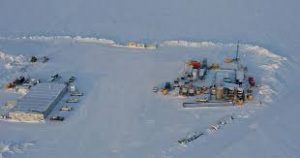
As rolling blackouts started to hit Oklahoma on orders from the Southwest Power Pool, Oklahoma Corporation Commissioners met Monday to issue an emergency order to increase natural gas production for power generation in the state amidst the Arctic weather. Production had plummeted by 2 billion cubic feet a day.
But as they met via telephone, the commissioners were informed a Level 3 order, the Power Pool’s highest alert level was withdrawn as the situation had apparently eased slightly. Still, temperatures hovered in the low single digits during the afternoon emergency meeting of the regulators. Utilities had launched their blackouts with some homes and businesses losing electrical power for an hour or longer because of the lack of natural gas to run the power plants.
Brandy Wreath, director of the Commission’s Public Utilities Division called it a life and death matter and said the state’s “natural gas supply was at a dangerous level.”

“These are steps to take to save lives,” he told commissioners before they voted to return allowable natural gas production on unallocated wells from the restricted 50% to 100% for the next 14 days. The vote was unanimous by Commissioners Todd Hiett, Dana Murphy and Bob Anthony to in effect, turn on the valves and produce as much natural gas as possible.
The 50% rate had been in effective since March 2020 when the commissioners voted 2-1 to restrict production. A second vote was held in August 2020 with another six-month implementation date.
During the meeting, Commissioner Anthony tried to blame the natural gas production problem on the 50% prorationing rate he voted against last year.
“That has contributed to the shortage we face?” he asked of Wreath as Chairman Hiett interrupted and said, “That’s not established! Maybe that’s your opinion.”
Oklahoma Energy Secretary Ken Wagner joined the meeting following the vote and told commissioners that discussions over concerns of the impact of the brutally cold weather had been “literally rolling conversations for the 72 hours since Friday.”
“We need to unleash every tool we can,” he said in a phone call with the three commissioners.
Wagner said natural gas production in the state had plummeted from 6 billion cubic feet a day to 4 billion cubic feet a day.
PUD Director Wreath explained earlier that the Arctic temperatures had resulted in “significant concerns” as some natural gas operations experienced “freeze offs” which resulted in a “significant loss of gas pressures.”
He told commissioners that some of the freeze offs had occurred “before the storm hit” but he did not offer any explanation why emergency steps had not been taken over the weekend to avoid the drastic measures of rolling blackouts.
During the nearly 40-minute long meeting, none of the commissioners asked why a faster response had not occurred.
Later Monday, Southwest Power Pool Executive Vice President and Chief Operating Officer Lanny Nickell spoke during a news conference and explained reserve energy that had not been available at mid-day prompted the Level 3 order.
“We now have some reserve energy available. But we very well could be in the same situation again—maybe until Thursday.”
He said the SPP had been “planning for a week” and expected to rely on imports of reserve energy from neighboring states. But those reserves ended as the Arctic weather forced utilities in neighboring states to use them for their own production of electricity.






